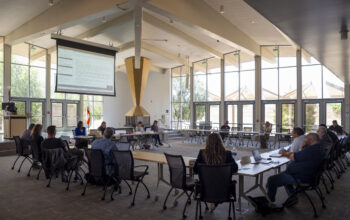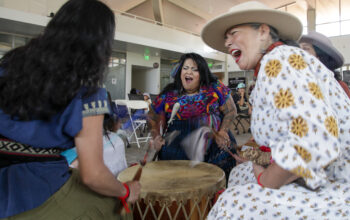Emily Kelley / Roundup
The expansion and remodeling of the Pierce College campus will continue into 2011 with two new projects on the way.
Scott Taylor of Swinerton Management Consulting, introduced two new construction projects at the Pierce College Council (PCC) meeting on April 22: the Facilities and Maintenance Project and the Horticulture and Animal Science Facility.
The Facilities and Maintenance Project, which will house offices, workshops and utilities, will be located behind the current Horticulture buildings across from Parking Lot 1.
The Project will feature “green technology,” such as solar panels to power the facility and other buildings on campus.
According to Taylor, the building plan has received a Gold rating by Leadership in Energy and Environmental Design (LEED), an organization that sets the standards of “green building” in partnership with the U.S. Green Building Council.
Some members of the PCC voiced concerns over the destruction of the surrounding area in order to build, since it is home to many trees and plants that have been on the property for years.
“There will be very little tree removal,” said Taylor, assuring the Council that the palm grove and other trees will either be unharmed or relocated.
The Project is expected to cost more than $21 million and is set to be completed by mid-2011.
The second project, the Horticulture and Animal Science Facility will be located along Brahma Drive on the far side of campus.
According to Megan Gorman of Hill Partnership Inc., a designer on the project, the facility will cost around $11 million dollars and will serve as a teaching tool for both students and faculty, as well as the community.
“The idea for the whole site was to bring in the community, the students, the rest of the campus, so that everyone can come in and use every part of the site,” said Gorman, after the presentation.
Some of the buildings will feature straw-bale construction, a technique that uses straw-bales as structural elements, as well as insulation.
“You can learn off of them,” said Gorman. Along with being a teaching tool, the straw-bale will help keep energy costs down.
“Between the southern classroom building and the western classroom building, there are different types of construction going on. So the student can not only learn about horticulture, but test their environment as well.”
The buildings have been designed to follow the Spanish architecture featured in the majority of buildings on campus, and the grounds will have a “natural California setting,” according to Woodward Dike, the landscape architect on the project.
The Facility will have four courtyards that can be used for teaching, and recycled wood lattice walkways that will offer protection from the elements. Greenhouses and a nursery will also be on the property.
A 10,000-gallon water tower will also be installed to provide irrigation to the greenhouses and grounds, and professors can bring classes there to learn.
The campus and the community can also enjoy an outdoor amphitheater that could be used for concerts or graduation, according to Gorman and Dike.
The complex is expected to be completed in late-2011.
—
ekelley.roundupnews@gmail.com

A computer rendering of what the Horticulture and Animal Science Center will look like. It is expected to be completed by late-2011. (Courtesy of Megan Gorman of Hills Partnership, Inc. )

The western classroom building. (Courtesy of Megan Gorman of Hill Partnerships, Inc.)



